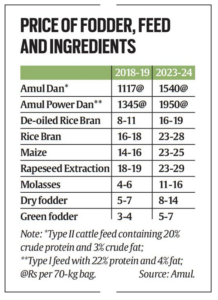India’s White Revolution 2.0: The Need for Action
Why in the news?
Rising milk prices and nutritional gaps in children from larger, poorer families highlight the need for renewed efforts to boost milk production and affordability in India.
About Importance of Milk and Nutrition:
- National Milk Day on November 26 marks Verghese Kurien’s role in the 1960s-70s White Revolution.
- Milk is essential for a nutritious diet, especially for children, but poor nutrition can have lasting negative effects.
- Larger families often spend less per person on milk due to financial constraints, impacting children’s nutrition.
Milk Spending Disparities
- A National Household Consumption Survey (2022-23) shows smaller families (one child) spend ₹43 per person monthly on milk, while larger families (two children) spend ₹376.
- Families in the highest income quartile spend nine times more on milk than those in the lowest quartile.
- Milk spending in two-child families is about 30-32% lower than in single-child families, especially in poorer households.
Policy Recommendations
- Public policy should promote milk consumption to address nutritional gaps in children.
- Programs like the “Gift Milk” initiative and school milk distribution help improve children’s health.
- Addressing rising milk prices and increasing supply is crucial for ensuring affordability, especially for poorer families.
About the Operation Flood (White Revolution 1.0):
- Origin: Inspired by the Green Revolution’s success, Operation Flood began in
- Role of NDDB: Led by the National Dairy Development Board, it aimed to create a national milk grid for streamlined production and distribution.
- Aim: Boost milk productivity and stabilise market prices.
- Objectives: Increase milk production, improve rural incomes, and provide affordable milk to consumers.
- Verghese Kurien: Known as the Father of the White Revolution, Kurien founded Amul and was pivotal in the success of Operation Flood.
- Phase I (1970-80): Established milk cooperatives with EEC and World Food Program funding.
- Phase II (1981-85): Expanded the dairy industry in Karnataka, Rajasthan, and Madhya Pradesh.
- Phase III (1985-96): Focused on veterinary care and breeding practices.
Need for White Revolution 2.0:
- Inflation in Milk Prices: Milk prices increased from Rs 42 to Rs 60 per litre over five years.
- Reduced Demand: Rising prices may lead to lower milk consumption.
- Higher Production Costs: Fodder, feed, and raw material costs have surged, raising procurement prices for farmers.
- Consumer Impact: Price inflation and increased production costs could lead to reduced demand for milk.
Sources Referred:
PIB, The Hindu, Indian Express, Hindustan Times




